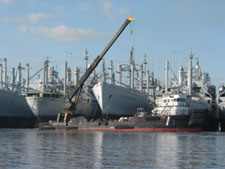National Defense Reserve Fleet
NDRF
The National Defense Reserve Fleet (NDRF) was established under Section 11 of the Merchant Ship Sales Act of 1946 to serve as a reserve of ships for national defense and national emergency purposes. The NDRF anchorages were originally located at Stony Point in New York, Fort Eustis in the James River in Virginia, Wilmington in North Carolina, Mobile in Alabama, Beaumont in Texas, Benicia in Suisun Bay in California, Astoria in Oregon and Olympia in Washington. At its peak in 1950, the NDRF had custody of 2,277 ships.
NDRF vessels are now located at the James River, Beaumont and Suisun Bay anchorages and at designated port facility berths. The program primarily consists of dry cargo ships with some tankers and military auxiliaries. As of March 31, 2009, there were 184 vessels in the NDRF. A Ready Reserve Fleet component was established in 1976 as a subset of the NDRF to provide rapid deployment of military equipment. Later, this became known as the Ready Reserve Force (RRF), which now numbers 50 vessels. In addition to maintaining ships for USTRANSCOM logistics, the Missile Defense Agency sponsors 2 ships for missile tracking. One vessel is currently operational and a second vessel is schedule to be delivered in FY2010. An additional 23 non-NDRF ships are also held for other Government agencies on a cost-reimbursable basis.
There are 30 vessels in retention status, which are preserved in a way that keeps them in the same condition as when they entered the fleet. Dehumidification of air-tight internal spaces is an effective means of controlling the corrosion of metal and the growth of mold or mildew. A cathodic protection system uses an impressed current of DC power that is distributed through anodes to the exterior underwater portions of the hull, resulting in an electric field that suppresses corrosion and preserves exposed surfaces of the hull. Cosmetic-appearance work is generally deferred, since it is not detrimental to the ability to activate and operate the vessel.
The Maritime Administration is the authorized disposal agent for Federal Government owned obsolete, merchant type vessels that are equal to or greater than 1500 gross tons. The obsolete vessels have been disposed through a variety of methods that include domestic and foreign recycling, sinking as artificial reefs and deep-sinking in conjunction with the U.S. Navy’s SINKEX Program. Of the 104 non-retention vessels in the NDRF, 64 are in the disposal process or are ready for disposal, and 40 are being prepared for disposal.
Through an authority to transfer government property to United States memorial ships, the NDRF program enhances U.S. maritime heritage by providing items that are no longer commercially available. Additionally, historic artifacts are loaned to worthy organizations, so they can present displays that are reminiscent of this rich heritage. Entire ships can also been donated for non-profit uses.
Prior to RRF operations, NDRF vessels supported emergency shipping requirements in seven wars and crises. During the Korean War, 540 vessels were activated to support military forces. A worldwide tonnage shortfall from 1951 to1953 required over 600 ship activations to lift coal to Northern Europe and grain to India. Another tonnage shortfall following the Suez Canal closing in 1956 caused 223 cargo ship and 29 tanker activations from the NDRF. From 1955 through 1964, another 698 ships were used to store grain for the Department of Agriculture. During the Berlin crisis of 1961, 18 vessels were activated and remained in service until 1970. The Vietnam conflict required the activation of 172 vessels.
In response to hurricane Katrina and Rita landfalls in 2005, the Federal Emergency Management Agency (FEMA) used the Maritime Administration’s vessels to support relief efforts. In addition to five RRF ships, four more NDRF ships were called. These ships supported the recovery mostly with messing and berthing for refinery workers, oil spill response teams, and longshoremen. To improve future ship-based responses, the establishment of a dedicated Disaster Relief Fleet is being promoted where rapid availability of prepositioned supplies and ship-based command centers can be provided.
There are eleven (11) ships being used for training purposes. The State Maritime schools in New York, Massachusetts, Maine, Texas, California and Michigan have six (6) ships that are used for training merchant marine officers. There are five (5) additional ships that are dedicated for military and homeland security training.
-
National Defense Reserve Fleet Inventory - March 2009
- Property Management and Archive Record System (PMARS)

